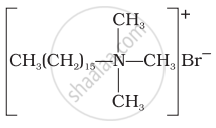Advertisements
Advertisements
Question
Polyethyleneglycols are used in the preparation of which type of detergents?
Options
Cationic detergents
Anionic detergents
Non-ionic detergents
Soaps
Solution
Non-ionic detergents
Explanation:
Polyethylene glycols are used to make non-ionic detergents.
APPEARS IN
RELATED QUESTIONS
Explain the following terms with suitable examples - Non-ionic detergents
Label the hydrophilic and hydrophobic parts in the following compounds.
CH3(CH2)10CH2OSO3 –Na+
Label the hydrophilic and hydrophobic parts in the following compounds.

Label the hydrophilic and hydrophobic parts in the following compounds.
`CH_3(CH_2)_16COO(CH_2CH_2O)_nCH_2CH_2OH`
What are anionic detergents? Give an example ?
Which of the following statements are correct?
(i) Cationic detergents have germicidal properties.
(ii) Bacteria can degrade the detergents containing highly branched chains.
(iii) Some synthetic detergents can give foam even in ice cold water.
(iv) Synthetic detergents are not soaps.
Match structures given in Column I with the type of detergents given in Column II.
| Column I | Column II |
| (i) \[\ce{CH3(CH2)16COO(CH2CH2O) nCH2CH2OH}\] | (a) Cationic detergent |
| (ii) \[\ce{C17H35COO- Na+}\] | (b) Anionic detergent |
| (iii) \[\ce{CH3-(CH2)10CH2SO3- Na+}\] | (c) Nonionic detergent |
|
(iv) |
(d) Soap |
Synthetic detergents have advantage over usual soaps as far as cleansing power is concerned. But use of synthetic detergents over a long time creates environmental pollution. How can the pollution caused by synthetic detergents be minimised? Classify the detergents according to their chemical nature.
Define the following:
Cationic detergents
Explain the following term with a suitable example.
cationic detergents

